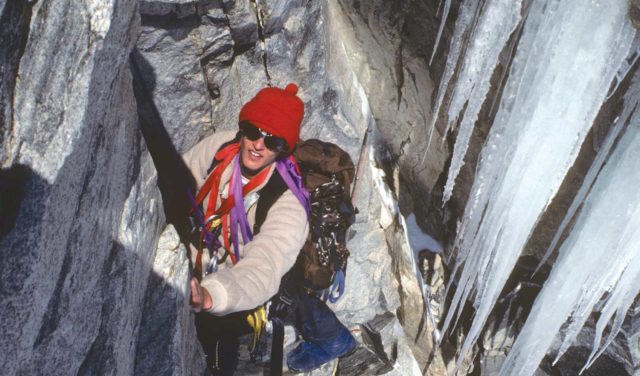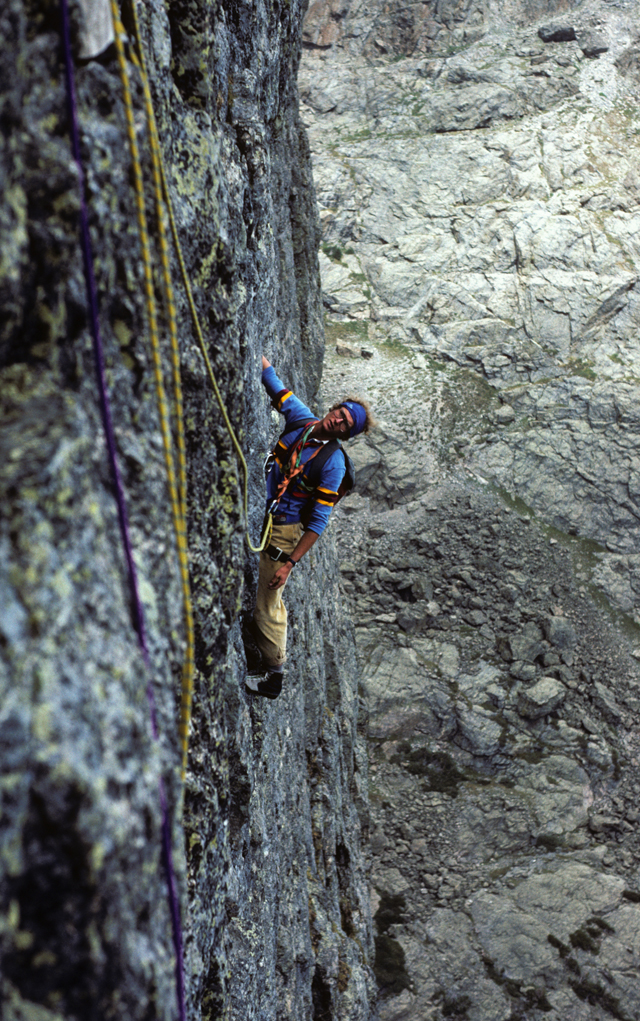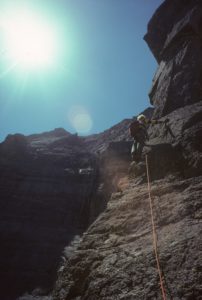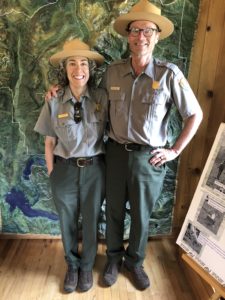
Bob Jamieson thinks he’s a regular guy. After a 30-foot fall shattered his ankle and broke some ribs, his back and a wrist three years ago, Jamieson climbed the Diamond’s face on Longs Peak this past August, his 80th attempt or so up the iconic mountain in some capacity. He may think he’s regular for someone from Boulder, but his story of recovery and tenacity amid tragedy and misadventure is anything but normal.
Early on the morning of Dec. 28, 2015, the now-61-year-old was climbing by himself at the Boulder Rock Club, like he’d done countless times before. After about six climbs, Jamieson decided to give a particularly challenging route a try. But in “a moment of inattentiveness,” Jamieson forgot to clip into the auto belay, he says. As he was about to top out, he fell, hitting the crashpads below.
“I was just trying a hard route for me and was just focused on the route and didn’t clip in,” he says, shaking his head. “I’m right in the perfect age, experienced climber, 55-65, and that’s the people who do that. It was a stupid accident.”
It all happened so fast. Jamieson didn’t have time to process the fact that he was falling. When he woke up, the paramedics were working on him at the bottom of the wall. “I was really hoping I was dreaming it at first, but then it was obvious that I wasn’t.”
He had a concussion, two fractures in his lumbar spine, a broken wrist, a couple of broken ribs and a “shattered” left ankle — his talus, tibia and fibula bones all broken, the ankle joint disrupted.
A climber for more than four decades, he’s experienced enough to know that a lot of people aren’t so lucky. If he’d been outside, climbing somewhere remote like he often does, the outcome may have been tragic. “There have been many things that made me more attentive,” he says, “but apparently not enough.”
There was the roped fall in 2010 when he swung about 13 or 14 feet, shattering his heel and ankle as he hit a “little ledge” while leading a pitch in Eldorado Canyon.
“I came back from that. It was a major surgery, the screws are still in there,” he says.
Then there was the fall that he hasn’t quite come back from, the one that’s affected him since 1984, the one that killed his younger brother, Lee.
• • •
Jamieson started climbing in 1973, learning the sport around Lumpy Ridge shortly after his parents moved the family to Estes Park just before he started high school. Nearby Rocky Mountain National Park (RMNP) soon became a second home. “It is hard to express how much the Park has been a part of me,” he says, having hiked, climbed and skied the mountainous terrain in every season almost his entire life.

Jamieson continued to climb while attending Colorado State University in Fort Collins, then worked as an adventure photographer for a bit, mainly filming ski mountaineering expeditions, and as a climbing guide with Colorado Mountain School. “You didn’t have to be good back then, you just had to know where the climbs were and stuff,” he says, insisting he really is just average.
Jamieson climbed Denali in 1976, took a mountaineering trip to South America in 1978 and completed a winter ascent of the Grand Teton in 1979. By 1980, his brother Lee had become his main climbing partner, despite the fact that Lee was 6 years younger and only 16 at the time. Jamieson taught his brother everything he knew, and the two often climbed together in both RMNP and Wyoming’s Wind River Range. While climbing in the latter, lightning once knocked them from an exposed ridge leaving them dangling from their anchor on a vertical wall. Miraculously, both were uninjured that day.

In 1981, Jamieson, Lee and a couple of friends spent 37 days traversing the Saint Elias Mountains in the Yukon Territory in an attempt to climb Mt. Kennedy. They ran out of food and missed reaching the summit by 500 feet, as a five-day snow storm forced them to retreat. “By the end of the trip we talked about M&M’s as if they were people,” Jamieson recalls. “Almost every page of Lee’s journal talked about food, and I still use his journal for a recipe for banana bread that he wrote on that trip. … It was a life changing experience for us.”
The next year Lee joined Jamieson and his best friend to this day, Andy Thamert, on an ascent of Mt. Waddington in British Columbia. What was planned as a five-day trip ended up taking the group nine days, and once again food and other people were scarce. While rappelling down, Jamieson knocked a rock loose that hit Lee in the knee and “caused a very challenging final descent,” Jamieson remembers. Although Lee recovered without the need for surgery, Jamieson was shaken by the experience.
“I felt a huge responsibility for Lee, partly because he was so much younger and I was almost like a parent, partly because I had knocked the rock that hit him, and partly because I had taught him climbing from the beginning,” Jamieson says.
Their last climb together was right in the middle of the Park, up the North Face of Hallet Peak. “The Park was home for us and we loved climbing there,” Jamieson says.
A few days later, Lee died.
On July 1, 1984, Lee, along with another climbing partner, left early to climb Notchtop in RMNP before having to be at work in downtown Estes by 1 p.m. “Even today, it would be considered a pretty big climb to try with a commitment to be back so early,” Jamieson says. But, “Lee had done Longs in an hour and 40 minutes, so moving fast in the mountains was normal for him.”
After reaching the summit, Lee and his partner followed Notchtop’s ridge down, heading for the steep left gulley that would take them back to flatter ground. Just before turning off the ridge, however, Jamieson says, a rock Lee was either holding onto or standing on broke loose and Lee plummeted 150 feet into the gulley below.
“We had done this climb and descent several times together — it is great and exposed, and we both liked the descent route right along the ridge crest, which I had showed him,” says Jamieson, who wasn’t with his brother that day.

It’s been 34 years since Lee passed, but not a day goes by that Jamieson doesn’t think of him.
“Lee and his accident are such a part of me,” he says. “I have wondered how my life would be different and what I would be like had it not happened.”
After Lee’s death, Jamieson didn’t do another alpine climb in the Park until 1994, when he climbed Hallet again. “It was like being injured without an injury,” he says of losing his brother.
• • •
The same year his brother died, Jamieson married his wife, Sumi, and eventually settled into the career life, working as one of the directors for Cheley Colorado Camps, running the hiking and backpacking program, and then as benefits director for Boulder Valley School District for about 15 years. The couple has two sons, who’ve grown up between Boulder and RMNP, adventuring with their parents, although Jamieson was reticent to get them climbing.
“We tried to keep the outdoor focus for our kids to regular stuff like hiking, camping, skiing, but we couldn’t stop them being who they are,” Jamieson says. “Now that our two kids are just about Lee’s age when he died, and they are climbing and backcountry skiing, and totally psyched up for big moments. It is challenging, but I love climbing with them.”
With a career and family, Jamieson still spent plenty of time climbing, either outside or in the gym, which, like most seasoned climbers, he considered “hokey” at first.
Up until the fall in 2015 in the Boulder Rock Club, Jamieson had never spent a night in the hospital. He stayed more than a week, recovering with the help of medical staff. With an external fixator to stabilize his leg, and the broken wrist, back and ribs, he couldn’t move on his own much. Two weeks after the fall, he had total reconstructive surgery on his ankle joint, which required four hours, two metal plates and about 30 screws. Meanwhile his friends built ramps all throughout his house so he’d be able to get around in a wheelchair when he went home.

He was in a backbrace (he calls it a “clam shell”) for about eight weeks, and a wheelchair for two or three months, unable to bear weight on his ankle, and unable to use crutches because of the other injuries. About 6 months later, the break further up his tibia had yet to heal, and the metal plate broke as well, requiring another surgery.
“I think one of the things that climbing teaches you is to deal with what is and not worry too much about the past,” he says. “Each moment is an opportunity to start over, and this accident certainly was good practice for that.”
By the end of November 2016, 11 months after the accident, Jamieson got the OK to go full weight bearing on his left leg. A month later he was climbing West Crack in Eldorado Canyon with his son. “It’s the easiest route there,” he defends.
He says his focus was walking at first, then he hoped to get back to hiking. “And then climbing was just like a bonus,” he says. “One thing that’s really helpful for me in climbing is that it’s slow.”
It took a lot of training to get back in shape for the Diamond. Jamieson went down to Mexico to climb with Bernardo Beteta, a seasoned CMS guide. He climbed in Eldorado Canyon with Steve Levin, the author of the area’s guidebook. He went to Red Rocks in Nevada several times. He did the North Face of Hallet Peak three different times with multiple partners and he hiked both the North Face of Longs and the route from Wild Basin with his son.
Then he set off for the Diamond with Buster Jesik, also of CMS. Jamieson says they first hiked 6 miles, sometimes on trail, often not, before climbing about five approach pitches, then starting up the 8-pitch route rated 5.10a, all above 13,000 feet.

“It’s not like 5.10a in the gym,” he says. “But we did the Casual Route, the easiest route on the Diamond, and that’s good enough.” The only photo he has is of his left foot on a ledge, the rocky cliff stretching out below. He never thought it’d be up there again.
Although getting to the top “felt remarkably good,” Jamieson says he couldn’t count it complete until he was safely back in the parking lot. The last time Jamieson had climbed and completed the Diamond was in 1983, back when Lee was still around.
A day hasn’t gone by that Jamieson hasn’t thought of his brother, he says, and he has yet to reclimb Notchtop, as well as one route up Longs. But he isn’t ruling out the possibility.
These routes “have such a strong connection to Lee that I have not repeated them,” he says. “I still may decide to go back to them — with the right partner. I’m not sure when, if ever, although I’m getting closer.”

After retiring in 2015, Jamieson lived out a lifelong dream, becoming a ranger — while still on crutches — in RMNP’s Wilderness Office. He and Sumi have spent the last several summers camping in a van, helping visitors with backcountry permits and enjoying the Park themselves. He still can’t run, or get his foot in a ski boot, which he hopes to do soon. But he can hike. And he can climb.
“Every moment, every day, is [an] opportunity to start over. Climbing is a lot about dealing with what is and just figuring it out. Whatever has happened, has happened,” he says. “[It’s] learning how to improvise. Coming up with new ideas and new approaches to solve problems. Learning that you generally have to let go to move.”














